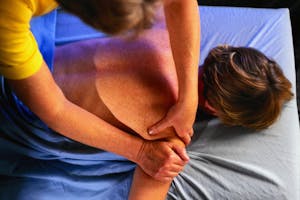
Manual therapy is a hands-on treatment by clinicians to treat muscle aches, joint pain, and limited range of motion. It encompasses a variety of techniques including soft tissue mobilization of muscles, specific joint mobilization, and joint high velocity low amplitude thrust techniques.
The three most notable forms of manual therapy are:
- High Velocity Low Amplitude Thrust (HVLAT) - the application of a rapid force into a joint(s) often associated with an audible popping sound called cavitation.
- Joint Mobilization - a slower velocity with differing amplitudes for pain control, muscular spasms, and/or improved mobility/ROM.
- Soft Tissue Mobilization – Utilization of many techniques to include effleurage, petrissage, transverse friction, and instrument assisted soft tissue mobilization of muscle/fascia tissues to facilitate healing and/or relaxation.
Is there a difference between manual therapy and physical therapy?
Physical therapy is a superset term used to describe a wide range of treatments, including manual therapy. Some physical therapy treatment techniques are hands-on, others are not. Manual therapy (also known as manipulative therapy) is a subset term under the physical therapy umbrella.
The International Federation of Orthopaedic Manual Physical Therapists (IFOMPT) definition of Orthopaedic Manual Physical Therapy (OMPT) is as follows: Orthopaedic Manual Physical Therapy is a specialized area of physical therapy for the management of neuro-musculoskeletal conditions, based on clinical reasoning, using highly specific treatment approaches including manual techniques and therapeutic exercises. OMPT also encompasses, and is driven by the scientific and clinical evidence and the biopsychosical framework of each individual patient.
A few examples of manual therapy treatment techniques include:
- Myofascial Release(also known as trigger point therapy) - a hands-on technique used assess and treat symptomatic areas soft tissue that may cause pain and limited function.
- Soft Tissue Mobilization - the use of gentle, slow, passive movements or gentle pressure to assess and treat soft tissue including muscle.
- Instrument-assisted soft tissue mobilization (IASTM) - involves the use of ergonomically designed hand-held instruments that physical therapists use to identify and restore full function. Examples of IASTM techniques include Graston Technique, HawkGrips, Guasha Tools, etc.
- Joint Mobilization - Joint mobilization involves the use of gentle, slow, passive movements to activate joints for the purpose of restoring motion and reducing pain and muscle spasms.
- High Velocity Low Amplitude Thrust Techniques – This technique is used as a “Control-Alt-Delete” for your nervous system and can assist in decreasing pain and/or stiffness and help restore function and ROM.
- Muscle Energy Techniques (METs) - a broad class of manual therapy techniques commonly used by physical therapists and other healthcare practitioners to increase range of motion, muscular hypertonicity (abnormally rigid muscles that hamper movement), and reduce pain.
Manual therapy has been shown to be an important part of an overall conservative treatment plan for a variety of conditions. Manual therapy is typically part of a complete treatment plan that is customized for your specific needs. Give us a call to learn how we can incorporate manual therapy into your rehabilitation program.
